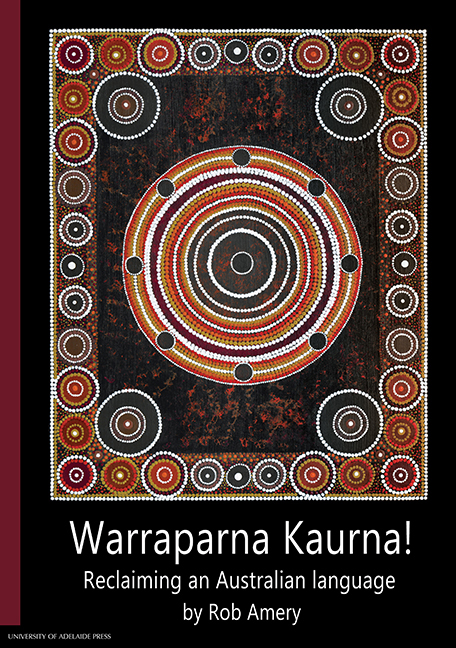Book contents
- Frontmatter
- Contents
- Maps, Plates, Graphs and Tables
- Preface to this Edition (2016)
- Foreword to the 2000 Edition
- Preface to the 2000 Edition
- Acknowledgements
- Abbreviations
- Conventions and Terminology
- Chapter 1 Locating the Study
- Chapter 2 Language Reclamation
- Chapter 3 An Ecological Approach to Language Revival
- Chapter 4 A Sociolinguistic History of Kaurna
- Chapter 5 Kaurna Sources
- Chapter 6 Restoring and Transforming the Kaurna Language
- Chapter 7 Kaurna Language Programs
- Chapter 8 Kaurna in Society
- Chapter 9 Kaurna Language Revival: The Formulaic Method
- Chapter 10 Sociopolitical Dimensions of Kaurna Language Revival
- Chapter 11 Into the Twenty-first Century: Developments since 2000
- Chapter 12 Summary and Conclusions
- Bibliography
- Index
Chapter 12 - Summary and Conclusions
Published online by Cambridge University Press: 28 July 2017
- Frontmatter
- Contents
- Maps, Plates, Graphs and Tables
- Preface to this Edition (2016)
- Foreword to the 2000 Edition
- Preface to the 2000 Edition
- Acknowledgements
- Abbreviations
- Conventions and Terminology
- Chapter 1 Locating the Study
- Chapter 2 Language Reclamation
- Chapter 3 An Ecological Approach to Language Revival
- Chapter 4 A Sociolinguistic History of Kaurna
- Chapter 5 Kaurna Sources
- Chapter 6 Restoring and Transforming the Kaurna Language
- Chapter 7 Kaurna Language Programs
- Chapter 8 Kaurna in Society
- Chapter 9 Kaurna Language Revival: The Formulaic Method
- Chapter 10 Sociopolitical Dimensions of Kaurna Language Revival
- Chapter 11 Into the Twenty-first Century: Developments since 2000
- Chapter 12 Summary and Conclusions
- Bibliography
- Index
Summary
We need to promote whatever is left of language for our kids, because thatstrengthens them in relation to the job they have to do in the future. I can't stressenough, that identity is crucial for Indigenous survival in this country. If we let itlapse in one form or another we will not survive as whole people. So it's crucialthat we marry the culture, the language and the identity to become the strengthof the future.
(Ngarrpadla Alitya Rigney, Discussion Panel at Launch of KL&LE unit, University of Adelaide, 31 July 1997, recorded on video)This study has traced the fortunes of the Kaurna language from its historical roots to its current incipient revival. There are two main periods in the development of Kaurna as we know it, the mid-nineteenth century and the 1990s onwards. In between these two periods little was documented and the language was scarcely used. In the words of Kaurna people themselves, the language was ‘sleeping’.
Initially, the Kaurna language was valued — Kaurna language skills acquired by sealers and some colonists were envied by others. The colonists and missionaries used the language for certain official and religious purposes and a school program operated between 1840 and mid-1845. This initial positive embracing of Kaurna was exceedingly short-lived. The Kaurna language was soon ‘written off’, even by those who had recorded it and invested considerable time and energy promoting it. Within two or three decades following colonisation, the Kaurna people were said to be ‘extinct’ or to ‘no longer exist’.
However, the Kaurna people have regrouped and are rising again as a distinctive people and a social and political force within Adelaide, and within South Australian Aboriginal affairs. The founding of Adelaide, the heart of the colony of South Australia, brought about the rapid demise of the Kaurna language. Now, paradoxically, the fact that the seat of government and the urban and commercial heartland of the state are embedded in Kaurna territory provides a political forum and a purpose for the use of Kaurna within the public domain that otherwise would either not exist or have far less impact. The Kaurna language is a powerful tool that the Kaurna people can use to fight for recognition and to celebrate their survival.
- Type
- Chapter
- Information
- Warraparna Kaurna!Reclaiming an Australian language, pp. 295 - 306Publisher: The University of Adelaide PressPrint publication year: 2016



